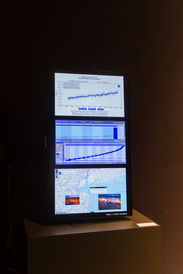To the core, and for the Record - MFA Thesis Show (2025)
'We are always looking at the Earth.
What if the Earth looked back at us?
Through the drilled land, what does She see?
Over 200 million years of witnessing…everything
storms,
extinctions,
invasions,
extractions
presidential elections.
Layers of Earth
skin and sweat
after dancing to slow songs with the cosmos
becoming dried bloody colors,
ghosts of ancient waters,
calcified fish, radiation,
occasional hematite
Memory itself is the bedrock
a record of time
becoming an edge with the rising waters of the ocean
Waves daring to wash the future off over and over again,
forgetting perhaps,
in tireless attempts to become a new wave,
until the whale breach becomes a flight into the sky
until everything mysterious becomes an old friend.
Natalie Romero

To the Core, and For the Record, is a research-based sound and video installation that uses local geological data and history to create a counter-archive conveying Indigenous history and ways of relating to the Earth. The project is also inspired by philosopher Edouard Glissant's theories of relationality and opacity from The Poetics of Relation.
The record has four songs containing data sonification and sound archives, including data from the Newark Basin Coring Project, sea level variations at Jersey Shore, and electromagnetic plant data from the Rutgers Ecological Preserve. The Sound installation and musical record was produced in collaboration with New Brunswick-based artist Miguel Romero-Trejos and with research support from geologists at Rutgers' Earth and Planetary Sciences Department.





















